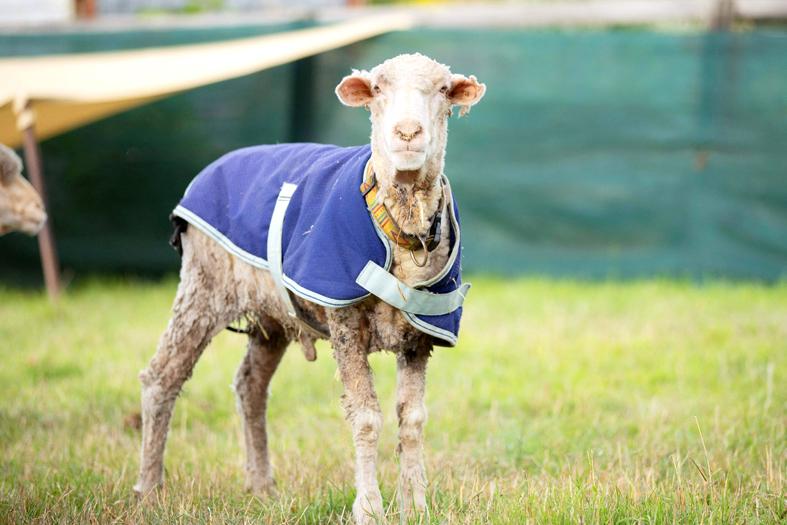A rogue overgrown sheep found roaming through regional Australia has been shorn of his 35kg fleece — a weight even greater than that of the famous New Zealand sheep Shrek, who was captured in 2005 after six years on the loose.
The merino ram, dubbed Baarack by rescuers, was discovered wandering alone with an extraordinarily overgrown wool coat, and was promptly shorn to save his life.
Kyle Behrend, from the Edgar’s Mission farm sanctuary, said that it appeared Baarack was “once an owned sheep” who had escaped.

Photo: Edgar’s Mission / AFP
Merino sheep do not shed their fleece and need to be shorn at least annually, as their wool continues to grow.
The hirsute ovine was found near Lancefield in Victoria, and rescuers said he had “eked out an existence” eating small shoots of grass.
“He had at one time been ear-tagged, however these appear to have been torn out by the thick, matted fleece around his face,” Behrend said. “He was in a bit of a bad way. He was underweight and, due to all of the wool around his face, he could barely see.”

Photo: Edgar’s Mission / AFP
Baarack is the latest in a long line of very large and woolly sheep to make international headlines.
In 2005, Shrek became a beloved celebrity in New Zealand after he spent six years evading capture and growing to a tremendous size.
He was eventually shorn of his 27kg fleece, and even met then-New Zealand prime minister Helen Clark, before he died in 2011.
A 2014 analysis estimated that Shrek’s fleece could be used to produce 47.3 sweaters.
Based on a 70 percent yield assumption, Baarack’s fleece would be the equivalent of 61.3 wool sweaters, or 490 pairs of men’s business socks.
In 2014, another escaped merino ram, called Shaun the Sheep, was found with a 23.5kg fleece in New Zealand.
All sheep, Baarack included, pale in comparison to Chris, a Canberran ram who was found in 2005 with a world-record 41kg fleece — twice his body weight.
Chris’ fleece was donated to the National Museum of Australia, where it sits in a large display case.
Behrend said that Baarack had adapted well to his new weight and was settling in with other sheep on the farm.

Shamans in Peru on Monday gathered for an annual New Year’s ritual where they made predictions for the year to come, including illness for US President Donald Trump and the downfall of Venezuelan President Nicolas Maduro. “The United States should prepare itself because Donald Trump will fall seriously ill,” Juan de Dios Garcia proclaimed as he gathered with other shamans on a beach in southern Lima, dressed in traditional Andean ponchos and headdresses, and sprinkling flowers on the sand. The shamans carried large posters of world leaders, over which they crossed swords and burned incense, some of which they stomped on. In this

‘NO COUNTRY BUMPKIN’: The judge rejected arguments that former prime minister Najib Razak was an unwitting victim, saying Najib took steps to protect his position Imprisoned former Malaysian prime minister Najib Razak was yesterday convicted, following a corruption trial tied to multibillion-dollar looting of the 1Malaysia Development Berhad (1MDB) state investment fund. The nation’s high court found Najib, 72, guilty on four counts of abuse of power and 21 charges of money laundering related to more than US$700 million channeled into his personal bank accounts from the 1MDB fund. Najib denied any wrongdoing, and maintained the funds were a political donation from Saudi Arabia and that he had been misled by rogue financiers led by businessman Low Taek Jho. Low, thought to be the scandal’s mastermind, remains

Near the entrance to the Panama Canal, a monument to China’s contributions to the interoceanic waterway was torn down on Saturday night by order of local authorities. The move comes as US President Donald Trump has made threats in the past few months to retake control of the canal, claiming Beijing has too much influence in its operations. In a surprising move that has been criticized by leaders in Panama and China, the mayor’s office of the locality of Arraijan ordered the demolition of the monument built in 2004 to symbolize friendship between the countries. The mayor’s office said in

FIGHTING CONTINUES: Thai military dropped 40 bombs on border areas, Cambodia said, while Bangkok said Phnom Penh launched heavy attacks and damaged homes Cambodia yesterday accused Thailand of intensifying its bombardment of disputed border areas, even as officials from the two countries attend a multi-day meeting aimed at negotiating an end to deadly clashes. The neighbors’ long-standing border conflict reignited this month, shattering an earlier truce and killing more than 40 people, according to official counts. About 1 million people have also been displaced. Cambodian and Thai officials were in their third day of talks at a border checkpoint, with ministers of defense from the two countries scheduled to meet today. However, the Cambodian Ministry of National Defense said Thailand’s military carried out a heavy